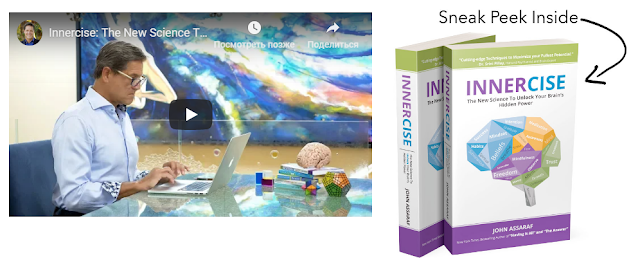
The Perfect Book That Complements My Neuroscience Research:
When it comes to writing popular books involving the brain, most people get it wrong. They don't understand how the brain really works, and they usually quote materials that are old, outdated, or downright false. In fact, if the person isn’t a neuroscientist or university professor, the odds are great that what you are reading is pseudoscience, or to it more bluntly, bs (and I don’t mean brain science!). Even fewer authors know how to offer strategies that can actually change neural activity in a way that will make you more calm, more focused, more optimistic, and more dedicated to pursue your goals in a committed and passionate way. John Assaraf’s new book, Innercise, succeeds where so many others have failed.
I have had the honor of working with John for nearly 10 years and was intimately involved in reviewing the book to make sure that the science was top-notch, written in a way that is both accurate and understandable. In fact, this is one of the very few books on brain training that I have endorsed and would recommend, and it’s filled with dozens of experiential exercises that really work. Here’s one of them:
AiA
This Innercise flexes all three of your core neuro-muscles. It’s called AiA (pronounced “eye-ya”) and stands for Awareness, Intention, and Action. Whenever you are feeling stressed, anxious, worried, unhappy, resentful, angry, or disappointed with any result or situation, pause and first do the Innercise “Take Six:” As the name implies, take six deep rhythmic breaths in through your nose and out through your mouth, like you are blowing out of a straw. As you breathe in, say, “I breathe in calmness, I breathe out stress.” Or you can say “I breathe in calmness, I breathe out fear.” Or “I breathe in calmness, I breathe out anxiety, or overwhelm.”
Next, do the AiA Innercise: In a calm relaxed frame of mind (as you gently breathe in and out) be aware of your physiology, your mental and emotional state, and the behavior you are engaged in. Next ask yourself “What is my intention for this moment?” Is it to be angry? Sad? Mad or frustrated, or to be calm and respond instead of react? Once you choose your intention, take one small, simple action-step toward achieving your goal. Learning this process teaches you to be in awareness and moves you out of an automatic reactive state and into a proactive state that you have more control over. With practice it can become the new default pattern that serves you well.
In John’s book, one of my favorite metaphors concerns your prefrontal lobe, where the decision-making circuits help you to take action. It's filled with both positive and negative inner speech and it actually "chatters" all day long. John likes to call it the Einstein and Frankenstein in your brain, and depending on how you listen to these voices, it can shape your overall optimism and/or pessimism about your future. The book is filled with wonderful original exercises and it makes a great contribution to the field of "practical neuroscience."






Комментариев нет:
Отправить комментарий